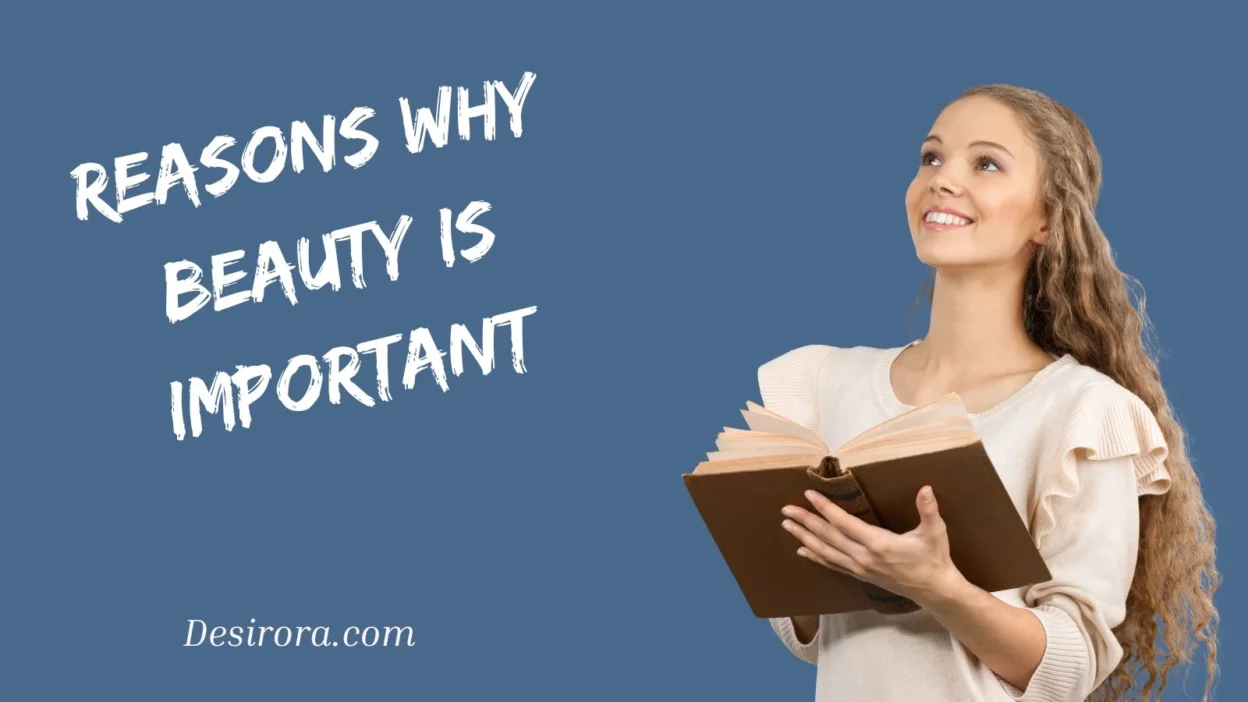Beauty surrounds us every day — in nature, art, people, music, words, architecture, and even in simple moments of kindness. It’s not just about appearance or vanity; beauty plays a significant role in our confidence, social life, health, and overall well-being. From ancient philosophy to modern science, people across cultures have tried to define beauty, but one thing remains clear: it deeply influences how we live, think, and connect.
Let’s explore the many reasons why beauty is important and how it touches every aspect of human life.
Understanding the Concept of Beauty
Beauty isn’t just about physical attractiveness. It’s a multidimensional concept that includes:
- Aesthetic beauty – pleasing forms, colors, and patterns (art, landscapes, design).
- Inner beauty – kindness, empathy, virtues, and character.
- Symbolic beauty – cultural rituals, traditions, and spiritual expressions.
- Functional beauty – harmony between form and purpose in design or architecture.
Philosophers like Kant and Schiller believed beauty was tied to truth, morality, and human reason. In contrast, modern thinkers highlight its role in emotions, identity, and everyday experiences.
Beauty is not limited to the eye of the beholder. It’s also a shared language that fosters connection and mutual understanding.
The Universal Language of Beauty
Beauty is universal — it transcends borders, languages, and cultures. A sunset in Paris can move someone in the same way as a dawn in the deserts of Arabia. Music, paintings, or natural landscapes evoke emotions without needing translation.
“Beauty is truth, truth beauty,—that is all
Ye know on earth, and all ye need to know.”
— John Keats
Examples of beauty as a universal language:
- Art: Michelangelo’s Sistine Chapel ceiling continues to inspire awe centuries later.
- Nature: The symmetry of a butterfly’s wings or the spirals of broccoli (fractal patterns).
- Music: Beethoven’s Ode to Joy unites choirs and audiences worldwide.
This shared appreciation of beauty creates connection, empathy, and peace, reminding us of our shared humanity.
Beauty and Personal Confidence
When people feel beautiful — whether through self-care, style, or inner growth — they often walk taller, smile more, and engage openly.
How beauty boosts confidence:
- A fresh haircut or a favorite outfit can spark self-confidence.
- Appreciating personal beauty helps in reducing insecurities.
- Being surrounded by beauty — calming spaces, art, or nature — enhances self-esteem.
It’s not vanity; it’s about recognizing and valuing one’s worth. Psychologists note that exposure to beauty triggers dopamine release, boosting feelings of joy and self-assurance.
Social and Cultural Value of Beauty
Beauty has always held cultural significance:
- In some societies, beauty symbolizes identity and belonging.
- Rituals, traditions, and clothing often reflect a community’s values and beliefs.
- Throughout history, beauty has influenced politics, governance, and strategy — from royal portraits to symbolic architecture.
For instance, ancient Greeks linked beauty with kalokagathia (the harmony of body and soul), while in contemporary culture, beauty shapes media, cinema, and even professional opportunities.
The Role of Beauty in Health and Well-being
Beauty isn’t superficial; it has real effects on mental and physical health.
- Stress Reduction: Beautiful scenery or calming art reduces stress by calming the nervous system.
- Hormonal Effects: Exposure to beauty releases endorphins and serotonin, promoting happiness.
- Restorative Impact: Hospital patients with views of nature recover faster than those without.
- Holistic Well-being: Beauty encourages mindfulness, reflection, and emotional balance.
Example: Spending time in natural landscapes — a garden, mountains, or the beach — promotes inner peace, reduces anxiety, and improves sleep quality.
Professional Success and First Impressions
Beauty and attractiveness often influence professional opportunities. Research shows people perceived as well-groomed or aesthetically pleasing are often seen as:
- More competent and intelligent.
- Better at communication and persuasion.
- More likely to succeed in client-facing or leadership roles.
But beauty in the workplace isn’t just about looks. Well-designed offices, thoughtful layouts, and aesthetically pleasing environments foster creativity, collaboration, and productivity.
Emotional and Psychological Benefits of Beauty
Beauty has a therapeutic effect on the mind. It uplifts, heals, and restores balance.
Emotional benefits include:
- Increased happiness and joy.
- Reduction in feelings of ennui or alienation.
- Greater empathy and emotional connection.
- A sense of meaning and purpose.
Idioms that show the link between beauty and emotions:
- “A sight for sore eyes” – something beautiful that brings relief or joy.
- “Stop and smell the roses” – appreciating beauty in life’s small moments.
Beauty in Nature, Art, and Everyday Life
Beauty isn’t confined to galleries or fashion shows; it’s everywhere:
- Nature: golden sunsets, snow-covered peaks, blooming gardens.
- Art: paintings, sculptures, cinema, literature.
- Everyday life: a child’s laughter, a well-cooked meal, architectural design.
| Form of Beauty | Example | Emotional Effect |
| Natural Landscapes | Grand Canyon, New York Arches National Park | Awe, calm |
| Artistic Creations | Beethoven’s symphonies, Frederick Crace’s alcove designs | Inspiration, elevation |
| Human Acts | Kindness, generosity, forgiveness | Connection, warmth |
Beauty as a Form of Expression and Identity
Beauty allows people to express who they are:
- Through fashion, hairstyles, or makeup.
- Through home décor and design choices.
- Through rituals, ceremonies, and cultural celebrations.
It helps people communicate identity, values, and belonging, serving as both personal expression and social signal.
Philosophical and Spiritual Dimensions of Beauty
From Plato to Hegel, philosophers viewed beauty as a bridge between the material and the spiritual. Beauty was considered a transcendental quality, along with truth and goodness.
- Religious traditions often use beauty — in music, architecture, and rituals — as a way to connect with the Divine.
- Beauty is seen as a gift, a form of grace, and a path to inner elevation.
For example, cathedrals, temples, and sacred art aren’t just decorative; they’re expressions of awe, reverence, and humanity’s longing for the infinite.
How Beauty Shapes Human Connection
Beauty encourages empathy, collaboration, and communication. A beautiful story, picture, or song helps people from diverse backgrounds connect emotionally.
Even in digital spaces like social media, people share beautiful moments — sunsets, children’s milestones, acts of kindness — to foster joy, gratitude, and community.
The Restorative and Therapeutic Effects of Beauty
Psychologists describe beauty as therapeutic. It helps the body and mind restore balance.
- Music therapy uses beautiful melodies to reduce anxiety.
- Art therapy helps individuals express emotions.
- Natural beauty encourages mindfulness and reduces cortisol.
Simply gazing at aesthetically pleasing scenes can have a calming effect on the nervous system, releasing tension and promoting relaxation.
Beauty Across Different Traditions and Societies
Different societies view beauty in unique ways:
- Japan values wabi-sabi — beauty in imperfection and impermanence.
- Western traditions celebrate symmetry and proportion.
- Indigenous communities often tie beauty to nature, rituals, and spiritual harmony.
Beauty is both diverse and universal, reflecting the values and beliefs of each culture.
The Evolutionary and Biological Reasons for Beauty
Beauty has evolutionary roots:
- Symmetry in faces and bodies is often seen as a sign of health and genetic fitness.
- Bright plumage in birds or flowers’ colors attract mates or pollinators.
- Humans naturally gravitate toward patterns, rhythms, and harmony.
Evolutionary psychology suggests beauty plays a role in species survival and propagation.
Beauty in Design, Architecture, and Creativity
From Frank Lloyd Wright’s architecture to the grandeur of European cathedrals, beauty in design inspires awe and functionality.
- Beautiful spaces foster creativity and concentration.
- Urban planning that values aesthetics improves quality of life.
- Artistic design creates a sense of pride and identity in communities.
The Symbolism and Significance of Beauty
Beauty often symbolizes:
- Hope and renewal.
- Strength and resilience.
- Love and connection.
It also plays a role in rituals, literature, cinema, and political symbols, shaping how societies perceive values and ideals.
Misconceptions: Beauty as Superficial vs. Essential
Some dismiss beauty as a secondary concern or even as vanity. But evidence shows beauty is essential to human well-being:
- It fosters joy, empathy, and emotional health.
- It influences social, professional, and cultural success.
- It shapes human connection, creativity, and identity.
Beauty isn’t just decoration — it’s integral to the human experience.
Practical Ways to Experience and Cultivate Beauty
Beauty is everywhere if we pay attention. Simple practices include:
- Spending time in nature.
- Decorating spaces with art, plants, or calming colors.
- Practicing self-care and appreciating inner beauty.
- Listening to music or poetry that uplifts the soul.
- Engaging in creative hobbies like painting or photography.
Tip: Start a “beauty journal” where you note daily beautiful experiences — a sunrise, a kind word, a song. Over time, this cultivates gratitude and mindfulness.
The Transformative Power of Beauty in Daily Life
Beauty transforms not just spaces but also minds, relationships, and societies. It encourages innovation, empathy, collaboration, and healing.
As Keats, Schopenhauer, and countless artists and thinkers have noted, beauty isn’t a luxury — it’s a necessity that enriches human existence.
FAQs
What are the main reasons beauty is important?
Beauty improves confidence, enhances well-being, strengthens social bonds, reduces stress, and inspires creativity.
Is beauty only about physical appearance?
No, beauty includes inner qualities, cultural expressions, art, nature, and acts of kindness.
How does beauty affect mental health?
It reduces stress, calms the nervous system, promotes happiness, and fosters mindfulness.
Why is beauty valued differently across cultures?
Because beauty reflects cultural values, beliefs, and traditions — from symmetry to spirituality.
Can beauty influence success?
Yes, personal appearance and beautiful environments impact confidence, communication, and professional opportunities.
Conclusion
Beauty is far more than skin deep. It’s a universal language that fosters joy, confidence, connection, and healing. From nature’s landscapes to human creativity, beauty shapes our health, emotions, relationships, and even societies. It inspires us, calms us, and gives life meaning.
Acknowledging beauty isn’t superficial — it’s essential to living fully, finding purpose, and experiencing the richness of the world.
Beauty isn’t just something we see. It’s something we feel, live, and share.

Thomas Hardy is a passionate innovator and thoughtful leader, dedicated to transforming ideas into lasting success. With creativity and purpose, he brings vision and authenticity to everything he does.



